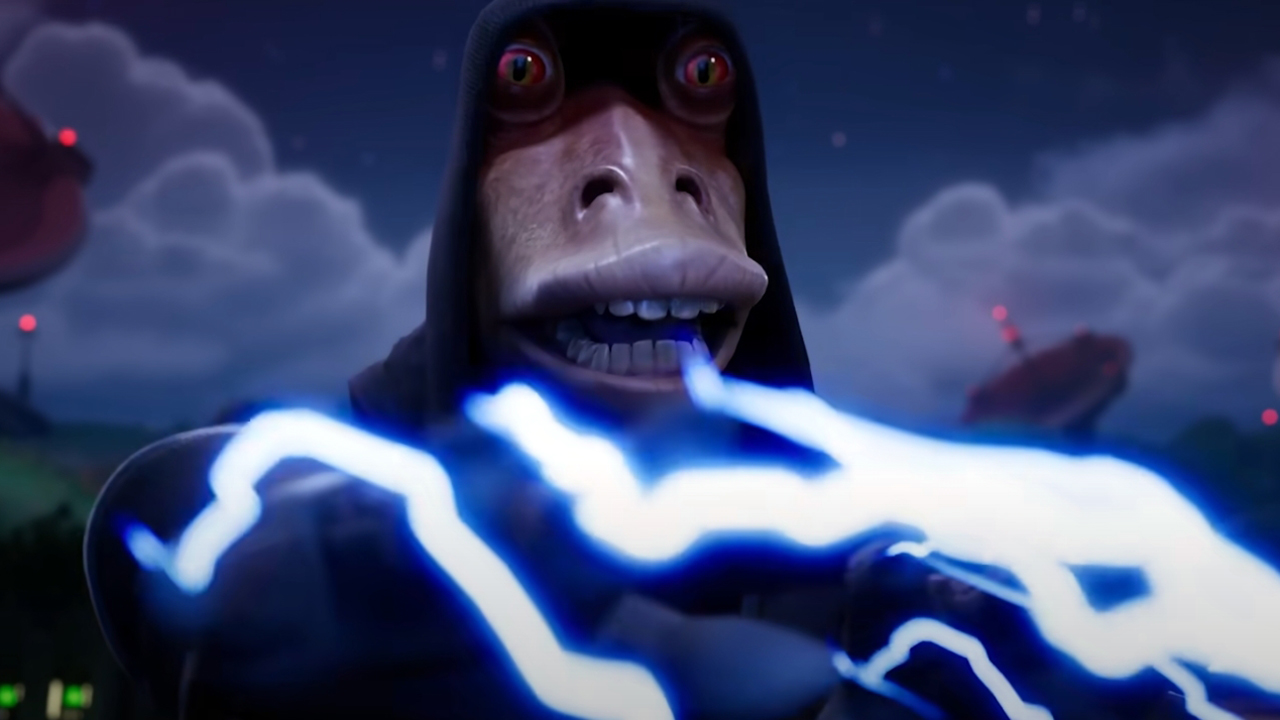September 2021
Asteroid explorer Lucy prepared for launch

Thursday, September 30, 2021: NASA's asteroid explorer Lucy is being encapsulated into a rocket fairing ahead of its launch on Oct. 16.
Lucy is the first spacecraft ever to explore the so-called Trojan asteroids, space rocks orbiting the sun in the orbit of Jupiter. The spacecraft, named after a fossilized australopithecus skeleton and a Beatles song, will embark on its 12-year journey from Cape Canaveral atop a United Launch Alliance Atlas V rocket.
During its landmark mission, Lucy will study up close eight different asteroids. Before it reaches its destination, it will take a close-up look at a space rock named Donaldjohanson, after the anthropologist that discovered the famous Lucy skeleton. Lucy will zoom past Donaldjohanason, located in the main asteroid belt between the orbit of Mars and Jupiter, in 2025.
In 2027, it will finally reach the orbit of Jupiter and commence its tour of the Trojan asteroids. -- Tereza Pultarova
First images of International Space Station with Nauka module released by Roscosmos

Wednesday, September 29, 2021: The first images of the International Space Station with the Nauka module attached, taken during a relocation of the Russian Soyuz capsule on Tuesday (Sept. 28), have been released by the Russian Space Agency Roscosmos.
Cosmonaut Oleg Novitsky, who piloted the Soyuz capsule during the relocation, shared the images on Twitter on Wednesday (Sept. 29).
"Yesterday, we re-docked the Soyuz MS-18 manned spacecraft from the Rassvet module to the new Nauka module," Novitsky said. "All according to plan! We managed to take unique images of the ISS in the new configuration."
Get the Space.com Newsletter
Breaking space news, the latest updates on rocket launches, skywatching events and more!
Cosmonaut Pyotr Dubrov took the images and a short video during the 40-minute relocation maneuver designed to free room on the Rassvet module for the Soyuz MS-19 capsule that will bring a Russian actress and a film director to the orbital outpost next week. The cosmonauts had to make a brief detour that took them 380 feet (120 meters) above the U.S. segment of the station to take the overview shots. -- Tereza Pultarova
Weather satellite captures launch of NASA's new Earth-watching spacecraft

Tuesday, September 28, 2021: The Goes 17 weather-forecasting satellite captured the moment when an Atlas V rocket with NASA's new Earth observation spacecraft Landsat 9 aboard lifted off from Vandenberg Space Force Base in California on Monday (Sept. 27).
Perched 22,000 miles (36,000 kilometers) above Earth's surface with a stable view of the American continent, Goes 17, operated by the National Oceanic and Atmospheric Administration, detected the streak created by the rocket as it sped through Earth's atmosphere in its water vapor channel.
Landsat 9 will be the ninth and most advanced satellite to study Earth from above for the Landsat program, a joint effort by NASA and the U.S. Geological Survey that has provided constant imagery of our planet for nearly 50 years. It carries a high-resolution camera and a sensitive infrared sensor that together can image the Earth across 11 spectral bands and resolve objects down to about 50 feet (15 meters) wide. The satellite should orbit the Earth at an altitude of about 438 miles (705 kilometers) over the planet's poles. -- Tereza Pultarova
Space tourists planting trees before trip to space station
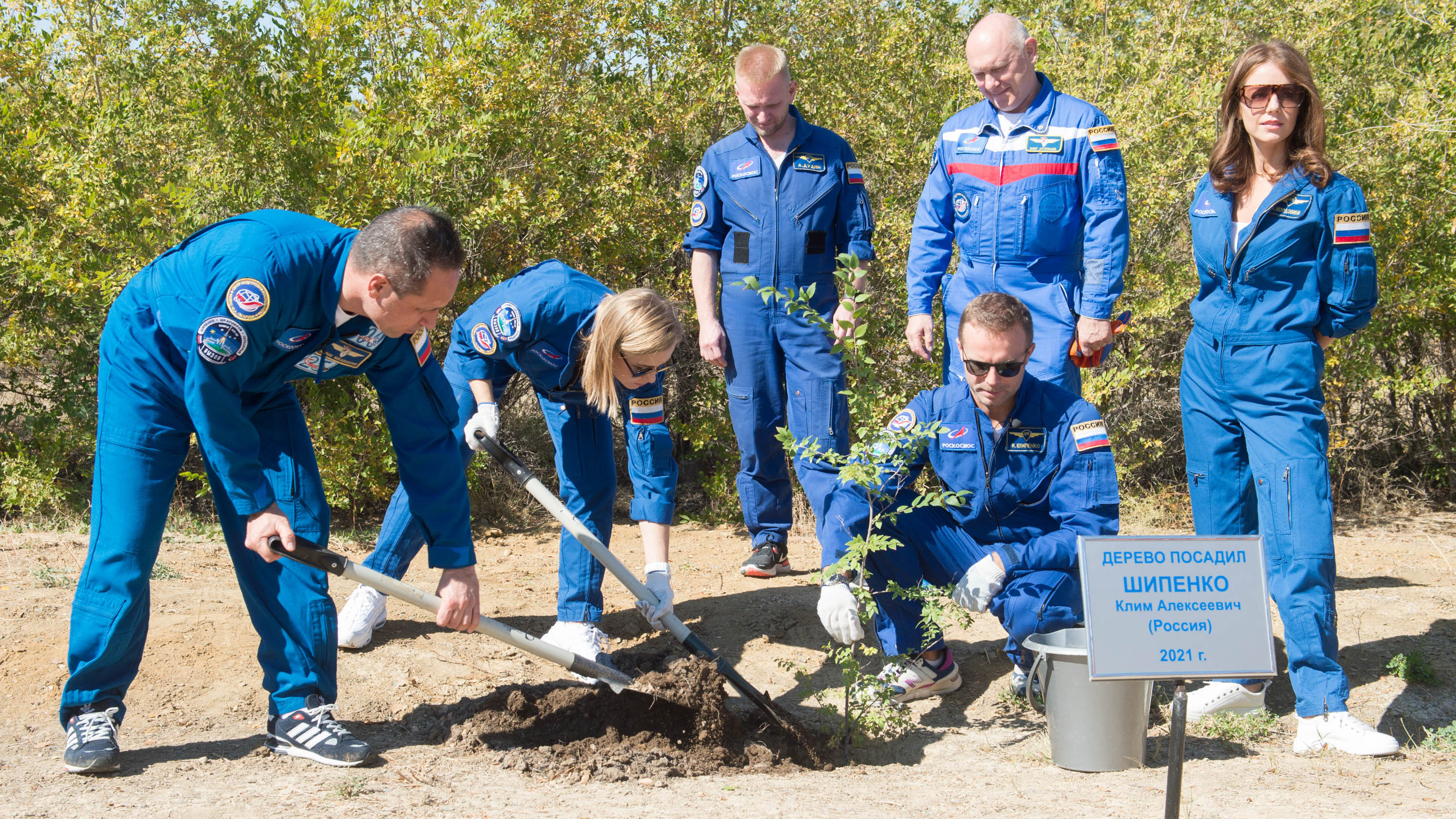
Monday, September 27, 2021: Russian actress Yulia Peresild and movie director Klim Shippenko plant trees at Russia's Cosmodrome Baikonur in Kazakhstan as part of a preflight ritual in an image shared by Russian cosmonaut Anton Shkaplerov on Twitter today (Sept.27).
Peresild and Schippenko will spend three weeks at the International Space Station filming a movie called The Challenge. They are scheduled to launch on Oct. 5 together with Shkaplerov on board Russia's Soyuz MS-19. They are expected to return to Earth on Oct. 17 with the current ISS commander Oleg Novitskiy.
"Eight days before launch: all crews strictly follow preflight traditions," Shkaplerov said in the Tweet. "One of them is related to the Alley of Cosmonauts, which is located next to Site 17 at the Baikonur Cosmodrome. First-timers plant a tree, and today was the turn of Yulia Peresild and Klim Shippenko."
Shkaplerov will remain on the orbital outpost until March next year. -- Tereza Pultarova
ExoMars orbiter provides glimpse into Mars' geological history
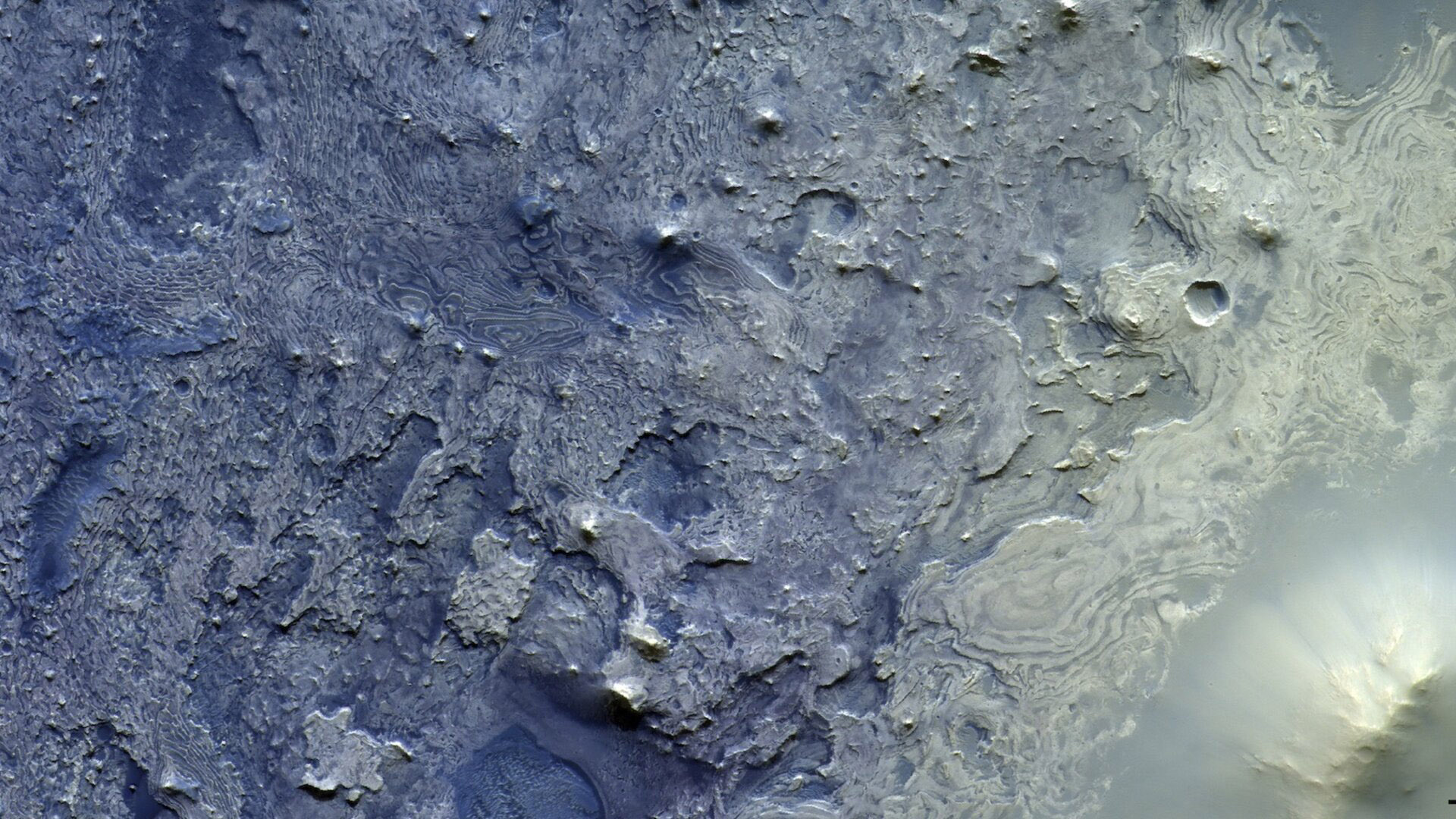
Friday, September 24, 2021: Layers of deposits inside a Martian crater can be seen in this image captured by the European Space Agency's (ESA) ExoMars Trace Gas Orbiter, providing a glimpse into the geological history of the planet and the erosion processes on its surface.
The image, captured on April 21 this year and released on Sept. 24, shows sediments inside the 30-mile-wide (50 km) crater located near the planet's equator which was likely created by an asteroid impact.
The lower layers of dark sand contrast with the brighter wind-eroded sedimentary rocks on top. In places faults created in past surface fractures cut through the layers creating gaps.
The ExoMars Trace Gas orbiter arrived at Mars in 2016 together with the Schiaparelli lander, which crashed during an unsuccessful landing attempt due to a computer glitch. In addition to imaging the planet's surface with its CaSSIS camera, the orbiter also samples Mars' atmosphere with unprecedented accuracy. The orbiter will also serve as a communication node connecting the ESA/Roscosmos Rosalind Franklin rover with Earth. The rover, which has been delayed several times, is now scheduled for launch next September. -- Tereza Pultarova
Day and night on Earth on autumnal equinox 2021

Thursday, September 23, 2021: The planet Earth seen on the Autumnal Equinox on Wednesday (Sept. 22) from 22,000 miles away by a European weather forecasting satellite.
The image, taken at 18:00 UTC, shows the planet split in equal halves along its north-south axis. While the eastern half, including most of Africa and Europe, is already submerged in the dark, the Atlantic Ocean and Americas are bathed in sunlight.
On the equinox, which happens twice a year, the Earth's axis, tilted by 23.5 degrees with respect to the plane in which the planet orbits, appears perpendicular with respect to the sun. As a result of that, the Southern and Northern hemispheres receive the exact same amount of sunlight. The day is a perfect 12-hours long all over the globe on these two days. The Autumnal Equinox marks the beginning of the fall and winter seasons in the Northern Hemisphere. The day will continue to shrink and with it, colder weather will arrive. In the Southern Hemisphere, the situation is exactly opposite. The next annual astronomical milestone, the Winter Solstice, will take place on Dec. 21. From that day on, the length of the day in the Northern Hemisphere will start to creep up again. It will match the length of the night on Spring Equinox on March 21 and continue to increase up to the Summer Solstice on June 21. -- Tereza Pultarova
Astronaut captures La Palma volcano glowing in the blackness of the night

Wednesday, September 22, 2021: European astronaut Thomas Pesquet captured this image of the erupting Cumbre Vieja volcano on the La Palma island from the International Space Station.
The image, shared on Pesquet's Twitter account on Wednesday (Sept. 22), shows glowing lava streaming from the crater surrounded by the dark Atlantic Ocean off the coast of West Africa.
"The #LaPalma volcano in eruption. Set against the blackness of the surrounding Atlantic Ocean, the bright orange glow is even more impressive," Pesquet said in the Tweet.
Cumbre Vieja erupted on Sunday (Sept.19) for the first time since 1971. The eruption was preceded by more than 22,000 mild earthquakes, which alerted scientists to the magma bubbling up inside the volcano.
The slow-moving but unstoppable rivers of boiling lava have since destroyed over 300 houses and forced the evacuation of more than 6,000 people. Geologists worry the scorching lava might cause explosions and release toxic gas once it reaches the coast and mixes with the cool sea water. -- Tereza Pultarova
Satellite watches as holiday island volcano erupts after half a century
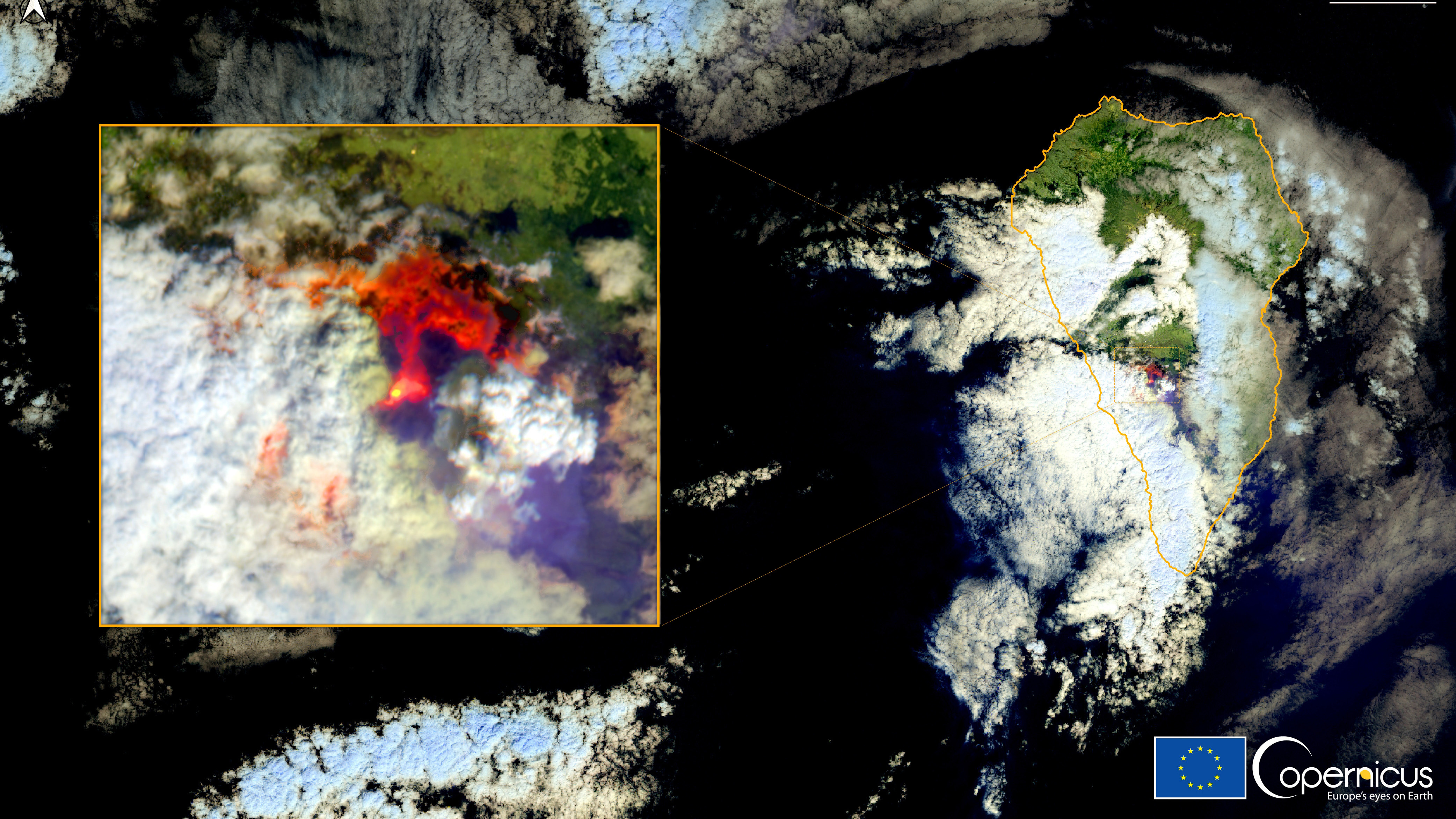
Tuesday, September 21, 2021: The Cumbre Vieja volcano on the Canary island of La Palma, west off the coast of Morocco, erupted for the first time since 1971 on Sunday (Sept.19). The European Sentinel-2 satellite captured the plume of smoke and streams of lava spilling from the volcano towards the western flank of the island on Monday (Sept.20) .
Sentinel-2 is part of the European Earth observation program Copernicus. Scientists working with the data have revealed this morning that the eruption has already destroyed 166 buildings in the Los Llanos de Aridane region as it spread towards the coast. The lava, according to this morning's estimates, now covers an area of about 103 hectares. Some 6,000 people have been evacuated and further evacuations are under consideration as geologists fear the more than 1,000 degrees C (1,800 degrees F) lava might trigger dangerous explosions and release toxic gas once it reaches the coast and mixes with the sea water, according to The Independent.
Scientists also monitor the spread of the volcanic ash and sulfur dioxide released by the eruption into the atmosphere. According to the Copernicus Atmosphere Monitoring Service (CAMS), the plume will spread northwards over the coming days and reach central France by the end of this week. -- Tereza Pultarova
Inspiration4 mission shares orbital family portrait with the view from above

Monday, September 20, 2021: Inspiration4 crew members posed for this group selfie in front of the dome window of their Dragon Crew capsule during their historic three-day all-civilian space trip.
At first glance, the image might seem rather ordinary. The clouds against the blue in this image, however, are seen from above, and the blue is not the blue of the sky but that of the ocean.
Inspiration4, the first ever all-civilian space mission successfully landed on Saturday (Sept. 18) evening. All crew members appeared in good spirits, despite reported problems with the spacecraft's toilet. -- Tereza Pultarova
Cancer survivor relishes space views from Dragon's cupola

Friday, September 17, 2021: Cancer survivor and civilian astronaut Hayley Arceneaux can be seen floating inside Dragon Crew's dome window, enjoying spectacular views of Earth during the first-ever all-civilian space mission Inspiration4.
Hayley is one of the four amateur astronauts on the historic three-day space trip. A physician assistant at the St. Jude Children's Research Hospital, where she herself used to be a patient, 29-year-old Hayley is the youngest American ever to fly in space. She is also the first ever space traveller with prosthetic body parts.
The St. Jude Children's Research Hospital is the benefactor of charitable proceeds from the mission, including a ticket raffle and an in-orbit fundraising performance by Hayley's colleague Chris Sembroski.
Inspiration4 launched from the NASA Kennedy Space Center in Florida on Wednesday (Sept. 15) at 8:02 p.m. EDT (0002 GMT). The crew is expected to splash down off the coast of Florida or in the Gulf of Mexico on Saturday (Sept. 18) -- Tereza Pultarova
Falcon 9 shooting up the sky with Inspiration4 crew members atop

Thursday, September 16, 2021: The plume of fumes generated by the SpaceX Falcon 9 rocket carrying four civilian astronauts of the Inspiration4 mission on their historic orbital trip was captured by photographer John Kraus shortly after the mission's lift-off from NASA's Kennedy Space Center in Florida.
The plume, backlit by the setting sun, was visible to observers from dozens of miles away as the rocket with entrepreneur Jared Isaacman, geoscientist Sian Proctor, physician assistant Hayley Arcenaux, and data engineer Chris Sembroski hurtled towards the sky.
The crew, which is expected to conduct scientific experiments and even sing and play ukulele to raise money for charity, is expected to splash down in the Gulf of Mexico on Saturday (Sept. 18). No update about the mission's progress has been shared since the launch at 8 pm EDT on Wednesday (Sept. 15). -- Tereza Pultarova
New Earth-observation satellite trains its eyes on the moon

Wednesday, September 15, 2021: This stunning image of the moon's surface has been captured by the recently launched Earth-observing satellite Pleiades Neo.
The satellite's operators used the Earth's natural companion to calibrate its sensors so that it can subsequently obtain perfect images of our home planet. Moon is apparently a great object for such checks because its surface looks almost smooth and reflects sunlight in a rather consistent way. Both Pleiades Neo satellites that are currently in orbit can look at the moon at about the same time, which enables the operators to ensure their images are of the same quality.
The image was released by the European Aerospace firm Airbus, which built and operates the two Pleiades Neo satellites, last week. The satellites, launched in April and August this year, image the surface of Earth with a resolution of 12 inches (30 centimeters). This level of resolution enables, for example, counting the number of people in the images.
Orbiting at the altitude of 385 miles (620 kilometers) above the planet's surface, the satellites cover an 8.6-mile-wide (14 km) swath of land in one sweep. The remaining two satellites are expected to launch next year, at which point the constellation will be able to cover the entire globe several times a day. -- Tereza Pultarova
Satellite captures record low ice extent in Arctic sea

Tuesday, September 14, 2021: The Laptev Sea in the Arctic can be seen completely free of ice in this image captured by the European Copernicus Sentinel-3 satellite on Monday, Sep 13.
The Laptev Sea, in the Russian northeast, is one of the coldest regions of the Arctic Ocean. With temperatures below 0 °С (32 °F) for the majority of the year, the Laptev Sea is one of the major ice-forming areas in the world's oceans. August 2021, however, saw the lowest sea ice coverage in the region since measurements began in 1980, according to the European Organisation for the Exploitation of Meteorological Satellites (EUMETSAT).
According to climate researchers, the Arctic region is on average experiencing faster warming than the rest of the planet, an effect that contributes to the fast melting of ice sheets and the rise of sea levels.
However, in other parts of the Arctic Ocean, scientists have reported a more optimistic situation this year. The U.S. National Snow and Ice Center said earlier this month that the overall Arctic sea ice extent has declined more slowly this summer than in previous years. The center expects that this year's minimum will be among the highest since 2007. In the Antarctic, where sea ice is currently at its maximum, the situation also seems optimistic, with monthly mean extent for August the fifth highest since satellite measurements began. -- Tereza Pultarova
ExoMars orbiter captures tectonic fissures on Mars

Monday, September 13, 2021: Europe's ExoMars Trace Gas Orbiter captured this image of a young volcanic region in the Elysium Planitia on Mars showing two parallel fissures that in the past had given rise to a frozen sea near the planet's equator.
The image, taken on April 14, shows the two 1.2-mile (2 kilometer) wide Cerberus Fossae trenches, crossing the volcanic region at about 10 degrees north. The floor of the nearly 620-mile-long (1,000 km) trenches is covered with coarse-grained sand that appears blue in the false-colored image, captured by the orbiter's CaSSIS camera. Geologists expect the sand inside the fissures, which are several hundred meters deep, to be made of basalt, a common volcanic rock that can also be seen in small impact craters that punctuate the plain.
Elysium Planitia is the second largest volcanic region on Mars. In 2005, another European orbiter, ExoMars, found what appeared to be a 500-mile-wide (800 km) ice sheet covered with ash in this region. Holding about as much water as the North Sea, the ice is believed to have come from underground water that had flooded the region through the two fissures captured in this image several million years ago. -- Tereza Pultarova
Italy at night - from space

Friday, Sept. 10, 2021: NASA Astronaut, Meghan McArthur has taken this photo of Italy at night from space. The photo was uploaded to her Twitter account and viewers can see the contrast between the darkness of the seas at night and the brightness of Italy and some of mainland Europe, in particular the cities of Rome and Naples.
McArthur took the photo on board the International Space Station and in the same tweet wrote that she is: "starting to learn night photography from our local ISS experts, Thomas Pesquet and Shane Kimbrough." -- Alexander Cox
A sparkly cluster

Thursday, Sept. 9, 2021: The dazzling globular cluster NGC 6717 sparkles in the constellation Sagittarius in this view from the Hubble Space Telescope released on Sept. 6. NGC 6717 is located more than 20,000 light-years from Earth an is roughly the shape of a sphere. Such globular clusters are packed in a way that they contain more stars in their centers than along their outer regions, according to the European Space Agency. Some of the extremely bright objects in the cluster are actually stars that are closer to Earth than NGC 6717, and happened to be in the view of Hubble They have clear X-shaped cross-hatching effects caused by interactions of their starlight and structures in Hubble's secondary mirror. -- Tariq Malik
Eclipsed moon shines over South American observatory
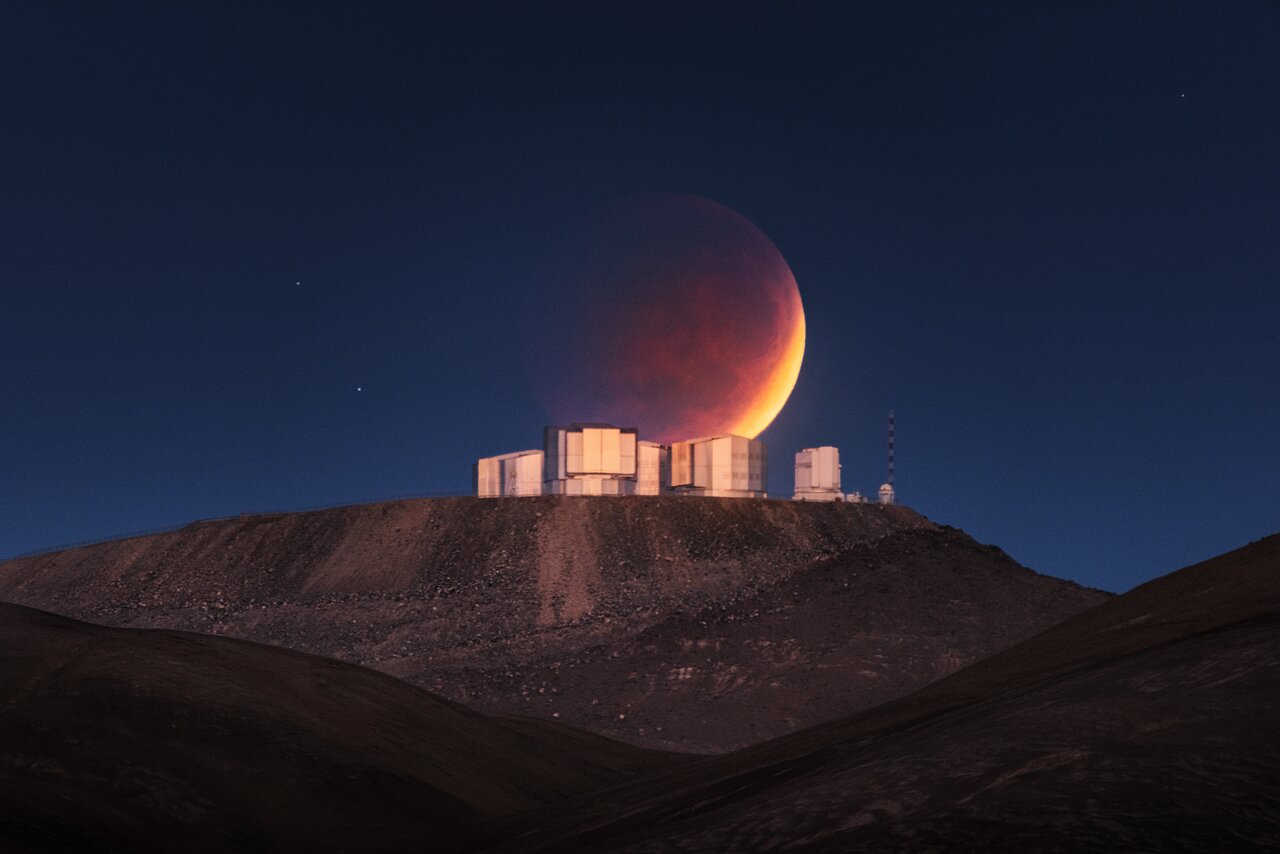
Wednesday, Sept. 8, 2021: Although May 2021's total lunar eclipse was visible to few skywatchers, plenty of people were able to admire the partially eclipsed moon. Astrophotographer Yuri Beletsky snagged a particularly stunning image of the eclipsed moon in early twilight as seen over Chile's Paranal Observatory, operated by the European Southern Observatory (ESO). Capturing the image required staking out a location about 5.6 miles (9 kilometers) east of the observatory, according to an ESO statement. -- Meghan Bartels
Virtual reality apps help astronauts service space station

Friday, September 3, 2021: NASA astronauts Megan McArthur is testing a virtual reality headset during experiments at the International Space Station.
The technology will help astronauts perform complex tasks autonomously without guidance from Earth, which will be critical for missions deeper into space, such as a trip to the moon and Mars, NASA said in a statement.
McArthur is wearing Microsoft's HoloLens headset, which has been delivered to the space station in April as part of the T2AR (T2 Augmented Reality) experiment. The headset runs custom-built AR software that helps astronauts inspect and fix pieces of hardware without having to call the ground control or look up instructions on a computer or a tablet.
Japanese astronaut Soichi Noguchi managed to repair a treadmill just with the help of the headset in April this year. -- Tereza Pultarova
Perseverance drills a hole to take a sample

Thursday, September 2, 2021: NASA's Mars rover Perseverance drilled this hole into a piece of rock dubbed Rochette on Wednesday (Sep 1), as it prepares to collect a precious sample to return to Earth in the future.
Scientists selected Rochette for Perserverance's second attempt to collect a sample after a failure on Aug 6. The first targeted rock eventually turned out to be too crumbly and fell apart before making it into the sampling tube.
This new image, showing a neat hole freshly drilled in the rock, was shared by the NASA Mars Perseverance Rover team on Twitter on Thursday (Sep 2).
"#SamplingMars is underway," the team said in the Tweet. "I’ve drilled into my rock target, and my team will be looking at more data and images to confirm if we were able to get and retain an intact core."
Perseverance landed on the floor of Mars' 28-mile-wide (45 kilometers) Jezero Crater on Feb. 18, tasked with hunting for signs of ancient Mars life and collecting dozens of samples for future return to Earth. -- Tereza Pultarova
Satellites capture Syrian oil spill approaching coast of Cyprus

Wednesday, September 1, 2021: A massive oil spill from a large refinery on the coast of Syria has spread into the Mediterranean Sea and is now threatening Cyprus, satellite images reveal.
The European Sentinel 2 satellite, part of the Copernicus Earth observation program, first imaged the spill on August 24. Since then, the oil slick, which originated at the town of Baniyas, has drifted northwards along the coast of Syria before being carried into the open sea and towards Cyprus.
This image, acquired by Sentinel-2 on Tuesday, August 31, shows a large amount of oil drifting less than 18 miles (30 kilometers) off the northern coast of the island.
Citing satellite image analysis company Orbital EOS, CNN reported that the oil slick was covering an area of 309 square miles (800 square kilometers), about the size of New York City. Local authorities on Cyprus reportedly predicted that the spill will reach the northern coast of Cyprus on Wednesday.
About 15,000 tons of fuel are believed to have leaked from the Baniyas refinery since Wednesday, August 23. The spill will likely decimate marine life in the region where many depend on fishing for their livelihood. -- Tereza Pultarova
Can't find the date you're looking for? It may have been a weekend or holiday, when we don't normally update our Image of the Day.
Click 'NEXT PAGE' below for October >
Check out our Image of the Day Archives for more awesome photos.
Image of the Day 2023 Archive

Image of the Day 2022 Archive
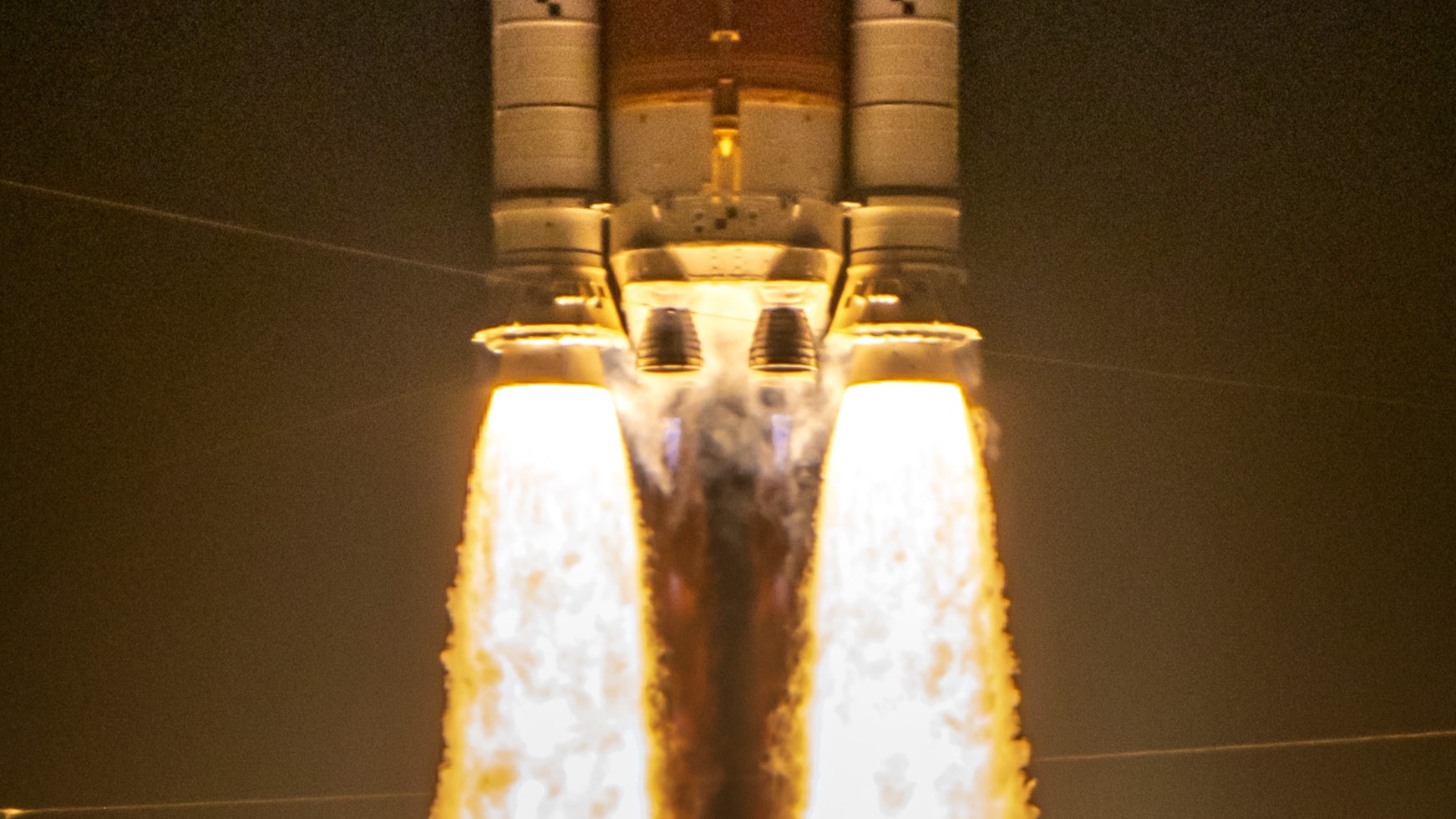
Image of the Day 2021 Archive

Image of the Day 2020 Archive

Image of the Day 2019 Archive

Join our Space Forums to keep talking space on the latest missions, night sky and more! And if you have a news tip, correction or comment, let us know at: community@space.com.

Space.com is the premier source of space exploration, innovation and astronomy news, chronicling (and celebrating) humanity's ongoing expansion across the final frontier. Originally founded in 1999, Space.com is, and always has been, the passion of writers and editors who are space fans and also trained journalists. Our current news team consists of Editor-in-Chief Tariq Malik; Editor Hanneke Weitering, Senior Space Writer Mike Wall; Senior Writer Meghan Bartels; Senior Writer Chelsea Gohd, Senior Writer Tereza Pultarova and Staff Writer Alexander Cox, focusing on e-commerce. Senior Producer Steve Spaleta oversees our space videos, with Diana Whitcroft as our Social Media Editor.







